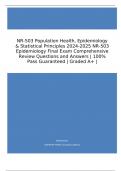NR-503 Population Health, Epidemiology
& Statistical Principles 2024-2025 NR-503
Epidemiology Final Exam Comprehensive
Review Questions and Answers | 100%
Pass Guaranteed | Graded A+ |
Administrator
[COMPANY NAME] [Company address]
, NR-503 Epidemiology Final Exam Comprehensive Review Questions
and Answers
1. Pandemic
There is human-to-human spread of the virus in
Phase 5
at least two countries. This phase means that
pandemic is immi- nent and that community
action and implementation of planned mitigation
2. cultural compe- procedures is needed.
tence
the ability of providers and organizations to
effectively deliver health care services that meet
the social, cultural, and linguistic needs of
patients.
is defined as "a dynamic, fluid, continuous
process where- by an individual, system or health
care agency find mean- ingful and useful care
3. Factors to be delivery strategies based on knowl- edge of the
ad- dressed for cultural heritage, beliefs, attitudes, and be-
Cul- turally havior of those to whom they render care"
compe- tent care
Communication (verbal and
nonverbal); personal space;
social
4. How do you as- organization;
sess an areas time perception;
re- sources and environmental control;
and its and biological
relationship to variations.
the health of a
region? By focusing on Population health take into
account the emergent properties of social
5. How does cul- structure, such as cultural norms, poverty, social
ture influence policies, and distribution of primary care
the decisions physicians, in conjunction with microlevel
a provider may properties, such as genetics, gender, ethnicity,
make when se- educational level, and individual health
lecting an inter- behaviors.
vention?
It influences how an individual might view an
6. Outbreak illness, how they seek care, and how they might
respond to therapy. Cultural issues play a key
, NR-503 Epidemiology Final Exam Comprehensive Review Questions
and Answers
role in compliance
, NR-503 Epidemiology Final Exam Comprehensive Review Questions
and Answers
More cases of a particular disease than
expected in a given area or among a specialized
group of people over a particular period of time.
7. culturally can help improve health outcomes and quality of
com- petent care and can contribute to the elimination of
health care racial and ethnic health disparities. ex. of
system strategies to move the health care system
towards these goals include providing relevant
training on cultural competence and cross
cultural issues to health professionals and
creating policies that reduce administrative and
linguistic barriers to patient care.
8. cultural
aware- ness is their understanding of the differences
between them- selves and people from other
countries or other back- grounds, especially
differences in attitudes and values.
Self-examination of one's own prejudices and
biases to- ward other cultures. An in-depth
exploration of one's own cultural/ethnic
background.
9. Ethics the principles of right and wrong that guide an
individual in making decisions
10. Fairness the state, condition, or quality of being fair, or free
from
bias or injustice; evenhandedness.
11. Social Justice the fair and equitable distribution of power,
resources, and obligations in society to all
people, regardless of race or ethnicity, age,
gender, ability status, sexual orientation, and
religious or spiritual background
12. Where is gy, population health, public policy and so-
the intersection cialjustice and vulnerable popu- lations?
of: epidemiolo-




